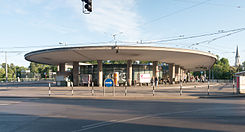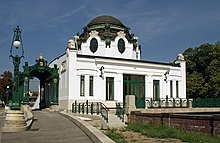Hietzing underground station
| Hietzing | |
|---|---|
| Underground station in Vienna | |

|
|
| The entrances to the station are on the Kennedy Bridge on a concrete oval | |
| Basic data | |
| District : | Hietzing |
| Coordinates : | 48 ° 11 '15 " N , 16 ° 18' 18" E |
| Opened: | June 1, 1898 (light rail) |
| Newly designed: | 1981 (subway) |
| Tracks (platform): | 2 ( side platform ) |
| use | |
| Subway line : |
|
| Transfer options : | 10 60 51A 56A 56B 58A 58B N54 N60 L |
The Hietzing station on Vienna's U4 subway line is located in the 13th district of Vienna, Hietzing ( Schönbrunn district ) , on the border with the 14th district, Penzing , and is combined with the Kennedybrücke traffic junction . In addition to the underground, tram lines 10 from Unter-St.-Veit to Dornbach and 60 from Rodaun to Westbahnhof stop here . The bus routes 51A, 56A, 56B and 58A have their terminus in Hietzing.
Location and special features
The station with two side platforms extends in the cut along the Wien River and Schönbrunner Schlossstrasse between the Kennedy Bridge and the former courtyard pavilion downstream. Since the entrance to Schönbrunn Zoo is in the immediate vicinity of the station , it was marked with a small stylized elephant in earlier subway network plans.
history
Steam tramway and steam light rail
The forerunner of today's underground station was the Hietzing stop of the steam tramway company formerly Krauss & Comp. which went into operation on October 27, 1883. When the plans for the Vienna steam light rail became more concrete, it had to give up its section Schönbrunner Linie – Hietzing in 1894 in favor of the new means of transport, making Hietzing the northern terminus of the steam tramway leading to Mödling .
The light rail reception building , built by Otto Wagner on behalf of the Commission for Transport Systems in Vienna , was on the western side of what was then Hietzinger Bridge, further away from the city center. The construction of the building was completed in March 1897, and the Upper Wiental Line was finally opened on June 1, 1898.
Electric light rail
From June 4, 1925, as a replacement for the steam light rail , the Vienna Electric Light Rail served the Hietzing station. The new operator, the municipality of Vienna - urban trams (WStB), built a third track as an intermediate turning system between the Hietzinger Bridge and the Badhaussteg between the two directional tracks . For this purpose, the southern retaining wall there had to be removed over a length of around 250 meters and then rebuilt using the stamped concrete method , offset by around five meters . Hietzing was upgraded from a stop to a train station with a signal box . From then on - in accordance with actual requirements - not all trains had to be forced to and from Hütteldorf-Hacking .
The old Wagner station building was demolished in the course of the construction of the Kennedy Bridge, which was designed as a traffic junction and completed in 1963/1964. Since then, a small reception building, which houses a few snack bars, has been leading from street level to the two platforms in the middle of the bridge. An oval, eye-catching concrete flying roof runs around the reception building, the architectural characteristic of the bridge, delimited by the tram's turning loop .
Subway
The conversion of the Stadtbahn operation to the subway operation reached Hietzing on August 31, 1981, when the section from the Meidling Hauptstraße station was taken over by the U4. Subsequently, for about four months in Hietzing to continue to Hütteldorf, they had to switch to a rail replacement service until this section was also switched to underground service on December 20, 1981. The turning system from 1925, which was last used regularly by the city railroad on October 24, 1980, was also adapted for use by the underground. It was also connected to the main line coming from the direction of Hütteldorf, but is only used for push-in trains or defective trains. As planned, it was only used by the U2 / U4 double line in September 1981 , which, however, had to stop operating after just three weeks.
At the beginning of the 2000s, barrier-free access was built using elevator systems from the sidewalk level to the two side platforms. The elevators are not located in the reception building, but on the eastern, center-side edge of the bridge.
On September 2, 2017, the former tram line 58 was discontinued and lines 10 and 60 took over their sections. For this purpose, a new track connection was added, which makes it possible to drive around the reception building on the Kennedy Bridge in left-hand traffic. The westernmost track, on which line 58 in the direction of Unter-St.-Veit ran until September 2017, has not been needed since then and is used as an additional parking space for the bus lines (e.g. 58A).
The court pavilion
The specialty of this station is the imperial court pavilion, which has been preserved (apart from the exits to the platforms), which Otto Wagner designed as a waiting room for the emperor and his entourage, although it was not included in the original plans for the Wiental line of the light rail. The imperial waiting salons in the large train stations of the dual monarchy were probably the model . Currently (2018) it is used by the Wien Museum as an exhibition space.
Web links
Individual evidence
- ^ Otto Antonia Graf: Otto Wagner. 1: The Architect's Work 1860–1902. 2nd Edition. Böhlau, Vienna 1994, pp. 134–248.
- ↑ Erich Schlöss: The Viennese light rail. Wiental and Danube Canal Lines (= contributions to urban research, urban development and urban design. Vol. 19). Magistrat, Vienna 1987, p. 43 ( online )
- ↑ Chapter Stadtbahn in: Städtewerk: Das neue Wien , Elbemühl, Vienna, 1928, pp. 98–115.
- ↑ Improvement on Kennedy Bridge
- ^ Bim castling on the Kennedy Bridge
- ^ Otto Antonia Graf: Otto Wagner. Volume 1: The Architect's Work 1860–1902. (= Writings of the Institute for Art History. Academy of Fine Arts Vienna. 2, 1). 2nd Edition. Böhlau, Wien et al. 1994, ISBN 3-205-98224-X , pp. 216-220.
| Previous station | Vienna subway | Next station |
|---|---|---|
|
Braunschweiggasse ← Hütteldorf |
|
Schönbrunn Heiligenstadt → |



